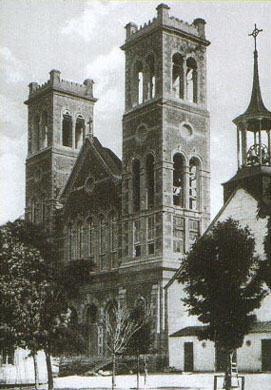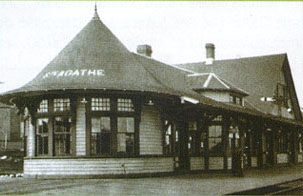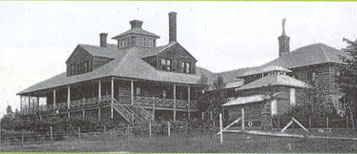 |
|||||


|
|
|
|||
|
|
|

|
|||
|
Français |
|
||||
|
Español |
|
||||
|
|
|
||||
|
|
|
||||
|
|
|
||||
|
|
|
Lodging |
Restaurants |
Directories |
Real Estate |
| Directories |
|
|
|||
| Weather |
|
||||
|
|
|
Page |
Mt-Tremblant |
St-Donat |
St-Jovite |
|
|
 |
|||||


|
|
|
|||
|
|
|

|
|||
|
Français |
|
||||
|
Español |
|
||||
|
|
|
||||
|
|
|
||||
|
|
|
||||
|
|
|
Lodging |
Restaurants |
Directories |
Real Estate |
| Directories |
|
|
|||
| Weather |
|
||||
|
|
|
Page |
Mt-Tremblant |
St-Donat |
St-Jovite |
 Visit the the Queen of the North.
Visit the the Queen of the North. Ste. Agathe owes its survival and its golden age to the efforts of Curé Antoine Labelle.
The curé envisioned a Catholic colony that would stretch beyond Ste. Agathe through the valley
of the Rouge River and northern Ontario all the way to Winnipeg. His principal objective was to
see a railroad built north through Ste. Agathe and onward to his destination. Sadly he died the
year before the railroad arrived in Ste. Agathe in 1892.
Ste. Agathe owes its survival and its golden age to the efforts of Curé Antoine Labelle.
The curé envisioned a Catholic colony that would stretch beyond Ste. Agathe through the valley
of the Rouge River and northern Ontario all the way to Winnipeg. His principal objective was to
see a railroad built north through Ste. Agathe and onward to his destination. Sadly he died the
year before the railroad arrived in Ste. Agathe in 1892. Ste. Agathe's sandy lake proved to be irresistible to the wealthy families of Montreal and the
northern United States. One of the first to arrive was Octavien Rolland, third son of J.B. Rolland,
founder of Rolland Paper. By 1910 almost every resident of Montreal's Golden Square Mile had a
residence around the lake or in the neighbourhood. Many of these homes are still with us. The
Baumgarten house overlooking the lake is one of the better known.
Ste. Agathe's sandy lake proved to be irresistible to the wealthy families of Montreal and the
northern United States. One of the first to arrive was Octavien Rolland, third son of J.B. Rolland,
founder of Rolland Paper. By 1910 almost every resident of Montreal's Golden Square Mile had a
residence around the lake or in the neighbourhood. Many of these homes are still with us. The
Baumgarten house overlooking the lake is one of the better known.|
All rights reserved |